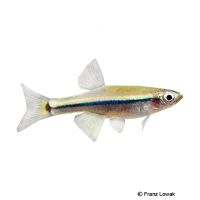Garnet Minnow (Aphyocypris lini)
| Garnet Minnow Aphyocypris lini | |
|---|---|
| Name | Garnet Minnow |
| Name Lat. | Aphyocypris lini |
| Synonym | Hemigrammocypris lini |
| Family | East Asian Minnows |
| Family lat. | Xenocyprididae |
| Order | Carps |
| Order lat. | Cypriniformes |
| Origin | South China |
| Habitat | Streams, rivers |
| Diet | Omnivore |
| pH | 6.5-7.5 |
| Behavior | Peaceful |
| Keeping | Group |
| Care Level | Easy |
| Reproduction | Egg scatterer |
| Breeding | Moderately difficult |
| Life Span | 3-5 years |
| Protection | No |
| Metric Units | |
| Size | 4 cm |
| Temperature | 18-23 °C |
| Hardness | 1-10 °dH |
| Aquarium | ~ 60 l |
| US Units | |
| Size | 1.6" |
| Temperature | 64-73 °F |
| Hardness | 18-178 ppm |
| Aquarium | ~ 15 gal |
Distribution and habitat
The Chinese Lampionfish are found only in the Pearl River basin in Guangdong Province in southern China. They prefer to live in shallow still water of fast flowing, clear rivers and streams with dense vegetation and a substrate of sand, gravel and foliage.
Maintenance
The aquarium should have a dense border and background planting, with roots that serve as a hiding and retreat opportunity and provide sufficient swimming space. With slightly shaded light (floating plants), a dark substrate covered with some foliage (e.g. sea almond leaves) and soft water they show the most beautiful coloration.
No ammonia, ammonium and nitrite should be detectable, the nitrate value should not exceed 100 mg/l. To ensure water quality and oxygen content, a filter and heater adapted to the size of the aquarium is required, as well as lighting for the species-appropriate day-night rhythm of the animals.
Diet
In the wild they feed mainly on small insects (approach food) and zooplankton. The food supply consists of live or frozen food, such as cyclops, daphnia, artemia and mosquito larvae or a commercially available frozen special food mix, supplemented with high-quality dry food (flakes, granules). They also like to eat mosquitoes, aphids, fruit flies and fruit flies. In addition, they need regular vegetable food, such as algae leaves or dry food with high vegetable content (spirulina, kelp).
Only feed as much as is eaten immediately (in a maximum of 10 minutes). Regular and varied feeding promotes health and increases resistance.
Behaviour and compatibility
They are sociable and peaceful fish, which should be kept in a group of at least 5 animals, but better much more. A socialization with other small, peaceful fish, such as Danio, Devario, Garra or loaches is very well possible.
Basically, only compatible fish species with similar demands on water condition and water temperature should be socialized.
Sex dimorphism
The males are more intensely colored and slender. The females are larger and stronger.
Reproduction and breeding
The male usually swims around (drifts) the female in the early morning, which spawns among fine-textured plants (Java moss). The larvae hatch after 48-72 hours and swim freely after a week.
Fry must be fed several times a day with special rearing food (Artemia nauplii, dust food). In a community tank breeding is hardly possible, because the spawn is easy prey.
Important
In the long term, temperatures above 23 °C are not tolerated.
They are often confused with the cardinalfish (Tanichthys albonubes), which occurs in the same area.
Chinese Lampionfish are also suitable for unheated indoor aquariums.
The well-being of the fish should be monitored regularly. Temperature should be checked daily, pH, hardness and nitrate levels at least every 14 days. Regular partial water changes are recommended, even if the contaminant level has not yet reached the upper limit. Sudden changes in water quality should be avoided. Newly introduced fish must be accustomed slowly to the water in the aquarium.
Further literature can be found in your pet store.
References
Text: Werner Winter; Image: Franz Lowak
Source: BMELV (1998): Tierschutzgutachten - Haltung von Zierfischen (Süßwasser); RIEHL & BAENSCH (2004): Aquarien Atlas Bd. 3, Mergus Verlag; ENGELMANN (2005): Zootierhaltung - Tiere in menschlicher Obhut: Fische, Verlag Harri Deutsch
- Gemäß § 21 Abs. 5 Tierschutzgesetz idgF
